Until now it has been relegated to an almost invisible position, its facade hidden behind a garden of trees. One may even find it hard to observe, while trying to navigate the river of electric toy cars driven by reckless toddlers in Skanderbeg square.
However, its 8,500 square meters have put the city of Prishtina into discord for a month now. The building that once housed the “Gërmia” shopping center, the first shopping center in the city, and is now home to the Tax Administration of Kosovo, lies on the site on which a concert hall is envisioned to be built.
The construction of a concert hall for the city was promised during Mayor Shpend Ahmeti’s election campaign last year, by which time, the former mall had already been pointed out as the desired location. The decision on the site however, was not received with the level of support a municipality may expect of a landmark project in the development of a city.
While it has remained clear in public discussion that a concert hall is needed in the capital, critics of the project include citizens and professionals in the arts and architecture fields, many of whom advocate for the conservation of the building given its architectural value and position in the collective memory.
Opponents to the project also question the need to sacrifice existing valuable spaces, and advocate for the end of a culture of “destroying the old, to build the new,” a motto that originated after World War II, continued well into the days of Yugoslavia and has resonated even stronger in 21st century Kosovo.
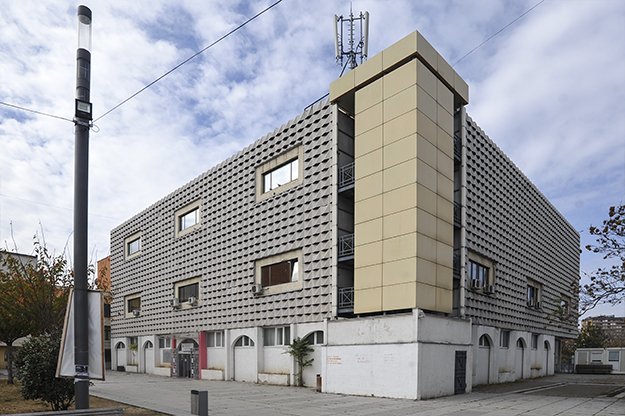
The site in the center of Prishtina selected for a new concert hall seemed all but finalized but has since faced a public backlash. Photo: Atdhe Mulla / K2.0.
The debate created among communities of artists and musicians, architects and urbanists, the municipality and others, has also been affected by a fear of losing the main sponsor of the project, the European Commission. Through the EU’s Instrument for Pre-Accession Assistance, a fund of over 15 million euros has been foreseen (but yet not approved) for financing the municipality’s concert hall project. However, the money has come with criteria that has complicated the decision-making process.
According to a declaration from the EU made on Facebook on Aug. 2, their conditions were that the concert hall site is on “suitable land in a landmark location,” and free of legal and technical impediments. Municipal sources meanwhile also state that the location found should be “free of strings attached,” visible, and have no problems with its ownership. However, the main resistance to the project centers around the fate of the building currently located on the site selected.
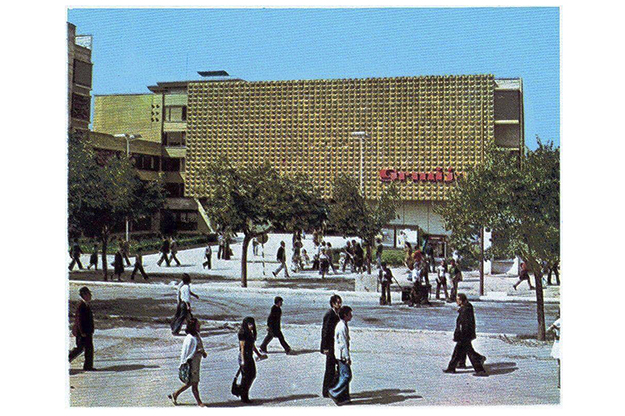
The former Gërmia shopping center, finished in 1972, is considered an example of modernist architecture. An online petition in support of its protection was launched in fear of its demolition in September. Photo: Creative Commons.
At the end of September, the organization DoCoMoMo, an international committee for the Documentation and Conservation of the Modern Movement launched an online petition to protect the Gërmia building. Represented in Kosovo by Bekim Ramku, DoCoMoMo’s petition was created due to strong concerns that the selection of the site would also imply the demolition of the former shopping center, a modernist building inaugurated in 1972, and one of the few remains of modernist architecture built during Yugoslavia in the heart of the city.
DoCoMoMo and the Kosovo Architecture Foundation, with support of other relevant organizations in cultural heritage protection such as Ec Ma Ndryshe, submitted a formal application to the Ministry of Culture and its respective institutions, to include the former shopping center in the List of Cultural Heritage Assets under Temporary Protection. On Oct. 10, the building was included on a newly published list guaranteeing its protection for up to a year, marking a victory for those wishing to prevent the demolition of what they felt was an identifiable icon in the landscape of the city center.
Though under temporary protection, it is still possible to intervene in the Gërmia building, however, options are more limited than before. As long as the building remains under this type of protection, any intervention must be reviewed and approved by the Institute for Protection of Monuments under the Ministry of Culture.
According to the Law on Cultural Heritage, temporarily protected assets receive the same level of protection as those under permanent protection. However restoration and conservation plans are only developed and put in place once the assets on the temporary list receive permanent protection.
The decision to temporarily protect the former Gërmia building, doesn’t therefore fully exclude a future concert hall built in this location, but public pressure has reopened the question of which site is most suitable for a future concert hall in Prishtina.
Alternative sites
Perparim Rama was the architect chairing the Technical Assessment team appointed by the municipality to evaluate the site of the concert hall. In spring 2018, he was tasked with simply evaluating the feasibility of the project at the Gërmia location, already picked out by the municipality.
He explained to K2.0 that his insistence with the municipality opened the way to proposing different potential locations. “There were many risks [if we only analyzed that site], and I insisted we had to open the process and look at other possibilities,” Rama says.
The technical assessment team also included Arianit Loxha, from the Association of Architects, and Besa Luzha, as a voice from the artistic community, as well as other representatives of municipal departments and the EU, who took part in discussions. Locations were evaluated on the basis of a set of criteria provided by the different parties involved, including proximity to the city center, access, visibility, potential as a catalyst for regeneration of an area, and the need to demolish an existing building on the site.
K2.0 has had access to the final scores of the sites evaluated to verify that the location that received most points and overall consensus was a site located behind the Palace of Youth and Sport, alongside the former Rilindja printing house. It obtained an overwhelming majority of points, a total of 159, with practically all the criteria received the maximum score during the evaluation.
“We found the location that is right, central, very visible in the entry to the city, with parking space, and a location that could help connect the city finally with the whole neighborhood of Arberia … and having the stadium nearby is technically also a non-issue,” said Rama.
The architect clearly saw a lot of opportunities with the site. “We could build a completely brand new site that has the potential of transforming the city, and we could create a new landmark building too,” he argues, adding that in fact, all actors expressed general consensus regarding the location, except one: “EU representatives insisted that it had to be Gërmia.”
The EU office in Prishtina told K2.0 that the site behind the Palace of Youth and Sports was inappropriate due to its proximity to the city’s sports stadiums. “The construction of the concert hall nearby the sport infrastructure is not appropriate because of the obvious differences in the security requirements and the set up in the case where two events (i.e. a football match and a concert) would take place at the same time,” a spokesperson for the office said.
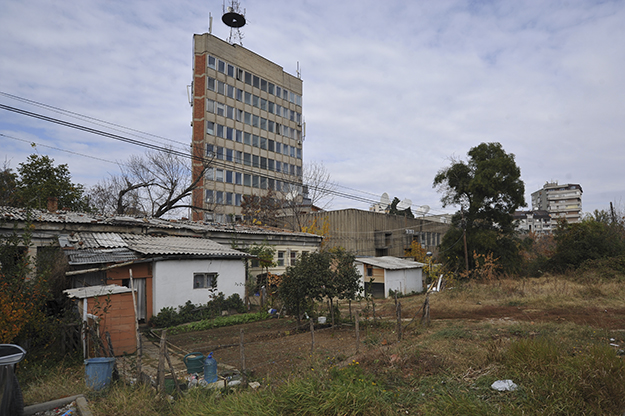
Alternative sites for the concert hall are now being discussed, including one close to the University of Prishtina campus. Photo: Atdhe Mulla / K2.0.
The Gërmia location received 122 points in the evaluation, the same as another site located on in front of the University of Prishtina campus, that includes part of the building that was formerly the home of Radio Kosova. Part of the existing building could be utilized as production space, while a new construction would be built on the site. According to Director of the Department for Culture at the Prishtina municipality, Yll Rugova, the EU are now open to considering this site as an option.
The mayor of the city, Shpend Ahmeti, seems to have his mind set on one site however, and has been vocal in questioning the value of the Gërmia building, repeatedly asking experts in TV debates that if they want to fight to protect this building, they should explain what the value of it is. “Let me build the concert hall,” said Ahmeti as a sort of ultimatum in a TV debate in Klan Kosova, after arguing that the decision must be taken quickly before the funds reserved by the EU are pulled out of the equation due to the controversy created and the lack of a decision on a location.
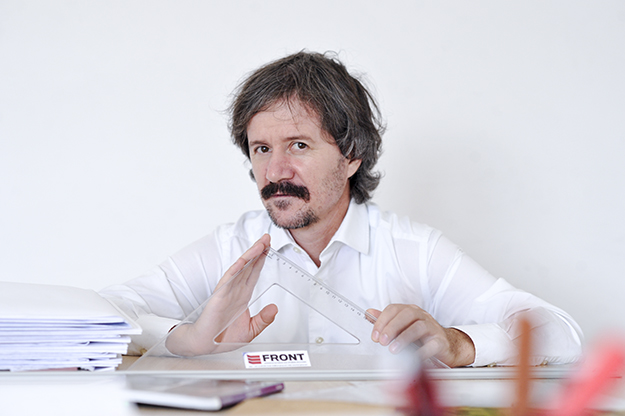
Professor Arber Sadiki believes that the building currently on the selected site is one of the most important built in Prishtina after World War II. Photo: Atdhe Mulla / K2.0.
However, Professor Arber Sadiki from the Faculty of Architecture and Urban Planning at the University for Business of Technology in Prishtina definitively sees the architectural value of the building. “Because of its architecture but also from its social context, it is one of the most important buildings of post-World War II Prishtina,” he says, recalling that prestigious Yugoslav architecture publications wrote about the building. “The geometrical purity of the volumes that form the object, the immensely authentic texture of its facade represent unique architectonic values, not only for that period of time, but for nowadays too,” the professor adds.
Ahmeti has defended his record on conservation publicly, stating that the municipality has intervened to protect buildings like Kosovo’s Central Bank, or the Students’ Menza (canteen). The municipality has also initiated a project to restore the city’s old town. However, its approach to the Gërmia building has been different.
Art historian Vesa Sahatçiu feels that the muncipality, and the public, should be more open minded in their definition of cultural heritage. “There is this tendency to underestimate the value of buildings built in the 20th century,” Sahatçiu says. “There is also this notion of cultural heritage [as something being] really old. I don’t think anyone is aware that there are now trends by very serious organizations trying to preserve modernist architecture and modernist buildings. It is not an outrageous idea.”
Sahatçiu cites the attempts of The Getty Foundation to preserve the National Library of Kosovo, a building often described as ugly and until recently ignored by Kosovar institutions as a similar example. “Prishtina has had a history of being torn down depending on the change of ideological and political systems, so it is extremely important to try and stop that kind of mentality and practice,” she warns. “If the old Prishtina is pretty much gone, with a small skeleton remaining, it’s extremely important to preserve a newer Prishtina and not try to change it, mutate it, to the point that is unrecognizable.”
For architect Rama, the possibility of constructing a concert hall on the site isn’t contingent on demolishing the building, stating that if the building needs to remain on the site, one possibility could be to construct a concert hall above the building, citing the example of the Elbphilharmonie in Hamburg.
Debates and divisions
The EU’s proposed criteria that the location had to be “suitable land in a landmark location”, has caused further debate about the exact nature of the city center. For Ramku from DoCoMoMo, the lack of updated regulatory plans of the city center makes open debate difficult. “When you don’t have a vision, when you don’t have a regulatory plan or guidance about the future of Prishtina, you don’t know how to reply to it,” he says.
The last regulatory plan for what is considered the epicenter of Prishtina, where the Gërmia building sits, dates back to 2005. No concert hall is foreseen in the regulatory plans of the city so far, and this implies that the Assembly of Prishtina would have to approve the inclusion of such concert hall in whatever location is finally decided as an update.
As an alternative, Ramku points to the example of Bilbao, where a neighborhood in economic decline outside of the center of the city was regenerated by the construction of the iconic Guggenheim Museum. For Professor Sadiki, the problem about choosing a “central” location goes even further. “The insistence that this object must at all costs be located in the center doesn’t stand, and I even consider such an insistence in essence to be some kind of cultural segregation, if not a cultural racism,” he says.
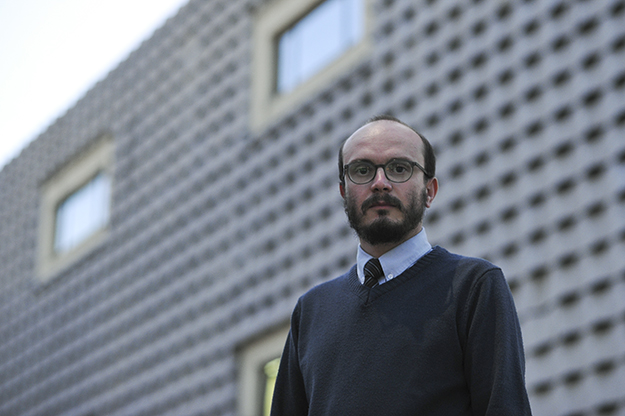
The debate has shown divisions within the municipality, with Director of the Department of Culture Yll Rugova publicly disagreeing with the mayor’s position on the conservation of the building. Photo: Atdhe Mulla / K2.0.
The unfolding of the debate has also shown a lack of transparency and a clear division in approach of the municipal team and its different party representatives. The director of the Department of Culture and member of Vetëvendosje, Yll Rugova, has spoken publicly against the mayor’s perspective, arguing that the Gërmia location should be protected and the concert hall project should not be developed there if that implies a demolition of the building.
“I really think that this building should not be destroyed, and if there will be a concert hall in this building it will be while transforming it and preserving the current facade and whatever the cultural heritage institutions consider that should be preserved,” said Rugova for K2.0, days after the building went under protection, highlighting that the building has both a high financial, as well as architectural value.
When asked about the future of the building, considering a potential withdrawal of funds by the EU if a location is not confirmed soon, he speaks about accepting the idea of a concert hall in a transformed Gërmia building. “To be honest, I agree with the mayor that it would be a shame to lose this building [to future misuses],” Rugova said when asked whether there is a solution in sight.
With the ghost of a potential demolition of the building floating around, art critic Shkëlzen Maliqi rescued in the midst of the debate an old proposal he made years ago, to transform this building into a museum of contemporary art, adding a layer of difficulty to find a consensual solution.
Just yesterday, the government of Kosovo took the decision to expropriate the socially-owned enterprises that shared ownership of Gërmia under the management of the Kosovo Privatization Agency. Prime Minister Ramush Haradinaj announced the decision on Facebook, adding that the building had been expropriated for the purpose of building a concert hall, “while conserving the architectural style as part of the memory, following the requests of the artistic communities.”
However, a public debate was held yesterday by the Association of Architects, who were involved in the technical assessment team of the project location. The meeting resulted in what Koha Ditore described as “no alternative solutions or conclusions.”
“The Gërmia building should be demolished, and a new building that breathes the present times should be built instead,” said one architect at the end, while the all-male panel got up leaving a number of people in the public complaining that they needed to continue the discussions.
For Ramku, the value of the Association of Architects in representing the architecture community of Kosovo is continually in question. “We have two associations, and their influence is diminishing,” he says, reflecting a larger division among those in charge of growing the city. “They don’t have any kind of influence over the architecture community, and they don’t speak on behalf the architecture community.”
Another debate is being more widely anticipated. Days after the publication of the online petition, Mayor Shpend Ahmeti announced via social media on Oct. 4 that a public debate would be organized at Kino Armata. However, weeks into the public debate and after that announcement, a date has yet to be announced.
Feature image: Majlinda Hoxha / K2.0.

